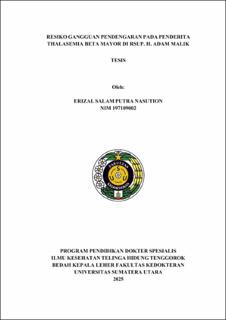| dc.description.abstract | The Risk of Hearing Impairment in Beta Thalassemia Major Patients in RSUP H. Adam Malik
Abstract
Background: Beta thalassemia major is a hereditary anemia disorder with a global prevalence of approximately 1 in 100,000 live births, more common in Southeast Asia including Indonesia. The disease causes various serious complications, including hearing impairment with varying prevalence. Hearing impairment occurs in more than 27% of pediatric patients undergoing iron chelation therapy, which can interfere with communication and cognitive function. Purpose: This study aims to examine the relationship between age, disease duration, transfusion frequency, ferritin levels, and hemoglobin with hearing impairment in pediatric patients with beta thalassemia major. Methods: This study used a cross-sectional design with a sample of 60 pediatric patients with beta thalassemia major. Collected data included age, disease duration, transfusion frequency, ferritin levels, hemoglobin, and hearing function examination results. Results: A total of 43.3% of patients experienced hearing impairment, with 16.7% having bilateral impairment. Analysis showed a significant relationship between patient age and risk of hearing impairment (OR 4.222 for age >10 years, p = 0.011). In addition, transfusion frequency was also significantly associated with hearing impairment (p = 0.049). However, ferritin levels (p = 0.715), hemoglobin levels (p = 0.511), and disease duration (p = 0.088) showed no significant relationship. Conclusion: Hearing impairment is a common complication in beta thalassemia major patients. Age and transfusion frequency are significant predictor factors for hearing impairment, while ferritin levels, hemoglobin levels, and disease duration show no significant relationship. Therefore, regular monitoring of hearing function is crucial, especially for older patients and those with high transfusion frequency, to reduce the impact of this complication.
Keywords: Beta thalassemia major, hearing impairment, risk factors | en_US |


